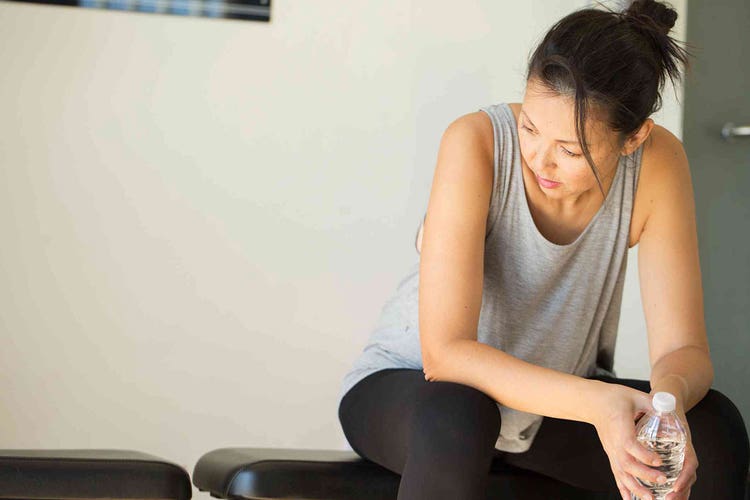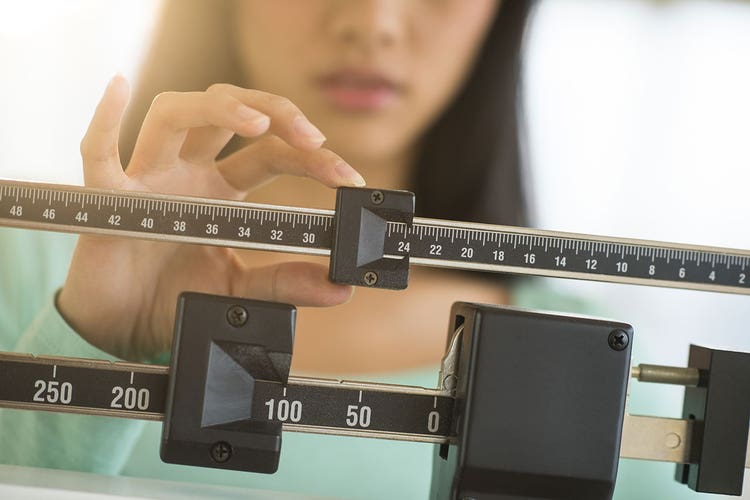Getting Fit at 40

In my late 30s, I began to feel as if my body were on its way downhill. My weight had crept up, and I’d developed osteoarthritis in my toes, making walking painful. Although I perceived myself as too young to be experiencing these changes, I also felt in my gut that reversing them was impossible.
I was particularly frustrated, since I hadn’t been neglecting exercise—anything but. Since college, I’d been swimming or using the elliptical or bike for about 45 minutes six times a week. (Sure, I never sweated while on a cardio machine, but I assumed that was just my nature—not a sign that I wasn’t exerting myself sufficiently.) Meanwhile, I hadn’t upped my calorie consumption. Could aging alone be responsible for this sudden uptick in weight, I wondered?
At a true loss and concerned about my joint pain, I decided to try working out with a personal trainer—something I’d avoided in the past. After all, I had always seen myself as uncoordinated and not athletic. I was loath to reveal my shortcomings to anyone else. Still, about 10 months ago, I ignored my fears and booked a session.
Nothing to fear

To my vast surprise, I felt comfortable with my trainer from the get-go, even though he emphasizes strength training. While many trainers do not encourage their female clients to lift heavy weights (many women are afraid of bulking up), he takes the opposite approach. Even when I think I won’t be able to lift a weight, he’ll tell me that I can. Each time I do, I feel a sense of empowerment. With each rep, I chip away at my belief that I am weak.
Oddly, although the sessions are very challenging, they’re also meditative. I’ve found that I relish focusing on each movement. In each moment, I am 100 percent concerned with pulling a cable, lifting a set of dumbbells or maintaining a plank pose. All other thoughts and concerns dissipate.
My trainer helped me see that although I had been consistent about exercise before, I had not been pushing myself enough. Now I know that cardio sessions should make me sweat—more than a mere misting. While lifting, I shouldn’t be able to talk comfortably. Even the first rep in a set should feel difficult. In fact, strength training should always feel difficult, period.
Forty and fabulous

Hooked, I upped my weekly routine to two hour-long sessions with my trainer and one solo 20-minute strength-training session at home. (I begin each trainer-led session with 10 minutes of intense cardio, usually on the treadmill.) On three other days, I push myself hard on the treadmill or elliptical, while on one other day, I swim. My total time spent exercising is about 4.75 hours per week, exactly the same as before—only now, it is allocated more strategically.
Meanwhile, my trainer helped me further improve my diet. Encouraged by what I’d read about the effectiveness of lower-carb regimens and the ill effects of sugar, I had already cut down to one serving of grain and one or two servings of fruit per day, one dessert per week and zero added sugar (other than that one treat). The result: I had lost 16 pounds.
In order to boost my metabolism and muscle mass, my trainer suggested that I also up my protein. Now, I eat two eggs and a whole-grain muffin with nut butter for breakfast rather than the (lower-protein) oatmeal or cereal I’d been choosing in the past.
Over the past several months, I have found myself becoming stronger and stronger, as my body has been converting fat to muscle. As if my form has been emerging from an amorphous block of marble, I’ve noticed soft spots transitioning to hard muscle and pounds dropping off. At this point, I’ve lost a total of about 30 pounds. Meanwhile, the pain in my feet has decreased significantly.
So when I finally turned 40 this past August, I felt a sense of pride and optimism. Not only had I taken action to reclaim my health, but my body was also more fit and toned than it had ever been, even in my 20s. A true convert, I plan to continue with my regimen going forward—for as long as I can.
The right time to start

It turns out that I’m not alone. “[People at 40] often see changes in their body that they don’t like, have more time than they did in their 20s and 30s [for self-care], and see family members’ health deteriorate, which causes them to take a look at themselves,” says Mark Langowski, CEO of Body by Mark Wellness, celebrity trainer and author of “Eat This, Not That! for Abs: The Ultimate Six-Pack in Less Than Six Weeks—and a Flat Belly for Life!” (Galvanized Books, 2015).
Kristin Kirkpatrick, MS, RDN, author of “Skinny Liver: A Proven Program to Prevent and Reverse the New Silent Epidemic Fatty Liver Disease” (Da Capo Lifelong Books, 2017), agrees, pointing out that many of her patients see the age as a midlife point, increasing motivation. “The body goes through some unfortunate changes around 40, like reduction in metabolism and the start of increased risk for some chronic conditions,” she says.
If you’re afraid that 40 is too late to ramp up your fitness routine, experts agree that is definitely not the case. In fact, “it is never too late to get healthy,” says celebrity trainer Gunnar Peterson, author of “The Workout: Core Secrets From Hollywood’s #1 Trainer” (William Morrow, 2005). “Studies have shown octogenarians improve their health as well as their body composition (lean-mass-to-fat-mass ratio), so 40 is still before halftime.” Kirkpatrick concurs, referencing a recent study showing that “individuals who had been sedentary most of their lives could help to reverse their fitness within two years if they engaged in physical activity.”
Change your routine for results

How should you revolutionize your fitness regimen at 40 or thereabouts? Since “we feel more aches and pains from exercise and it takes longer for our bodies to recover from small injuries” at 40, Langowski warns against transitioning from zero to daily exercise. Instead, he recommends making gradual changes and hiring a professional who will safely guide you through a custom program. “I generally recommend that people over 40 cut back on the amount of high-impact exercise they do and replace it with strength training and swimming, since our joints can’t handle the impact as well,” he says.
“Start with a manageable exercise program [physically and schedulewise], and make two simple dietary changes,” suggests Peterson, who advises exercising five or six days per week. “Every week or two, depending on how easy the changes have been to implement, fix one more thing until you have a comfortable balance.” He also recommends that you avoid processed foods and that you drink enough water and get enough sleep. While Langowski counsels monitoring the consumption of refined carbs and sticking to whole foods, Kirkpatrick advises that you follow a “smart” carb diet, “lower in carbs yet high in nutrients and fiber.”
Photo credit: Ridofranz, thinkstock; digitalskillet, thinkstock; Jacob Lund, Adobestock; tmc_photos, Adobestock; satyrenko, Adobestock